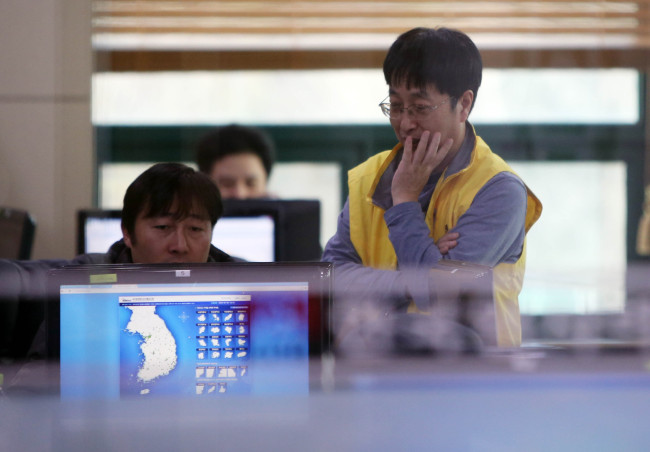World sets out to detect traces of radioactive gases
By Shin Hyon-heePublished : Jan. 8, 2016 - 16:42
South Korea, the U.S., Japan and other countries and organizations are spurring efforts to discover traces of radioactive materials released during North Korea’s recent nuclear test to better decipher the event and ratchet up pressure on the wayward regime.

Seoul’s Nuclear Safety and Security Commission has launched an emergency operation team with the Korea Meteorological Administration and Korea Institute of Nuclear Safety to analyze the experiment through two xenon detection devices and 134 automatic radiation monitoring systems across the country.
They look for any whiff of radioactive gases in the atmosphere, in particular xenon, a product of uranium and plutonium fission alongside krypton. When a nuclear device detonates, the substance may be picked out by monitoring stations installed nearby the location and in the way of the winds that carry it.
Daejeon-based KINS said Friday it has begun examining the first set of samples salvaged a day earlier in the East Sea and will continue its work as the second batch arrives at night, noting that the results of the initial analysis may come out late in the day.
But Seoul officials raised the possibility that the equipment will turn out to have failed to find any evidence. A number of stations detected xenon following Pyongyang’s first atomic test in 2006 but did not catch anything after its larger blasts in 2009 and 2013.
“During the latest two cases, they could not collect radioactive gases probably because of screen fences set up in front of the tunnels at the nuclear complex,” a military official said on customary condition of anonymity.
“It’s something we should do necessarily government-wise, but you better not have such high expectations.”
With the monitoring activities taking place around the globe, the Comprehensive Nuclear-Test-Ban Treaty Organization, which runs 337 facilities worldwide, said it may be able to gather proof at two stations in Takasaki in central Japan and the U.S.-administered Midway Island in the North Pacific Ocean.
“The earliest we expect results would be tomorrow morning,” Elisabeth Wachter, a spokesperson of the Vienna-headquartered institution’s preparatory commission, was quoted as saying Thursday by Radio Free Asia.
The U.S. Air Force has also reportedly deployed the WC-135 “sniffer” aircraft in a detection mission over the peninsula, as it did following three previous tests, but yet to release the findings.
But Japan’s Nuclear Regulation Authority said Thursday that it has not found “artificial radioactive nuclides” from samples picked up Wednesday by three air force planes, adding there was “no particular change” in radiation levels assessed at some 300 monitoring posts across the archipelago.
Controversy, meanwhile, is boiling after U.S. media reported that Washington was aware of Pyongyang’s test preparations for two weeks and launched drones to collect air samples near the site.
The South Korean government has come under fire for its failure to spot any signs of the experiment in contrast to a senior military official’s earlier remark before the parliament that it is capable of foreseeing an upcoming explosion up to a month ahead.
As lawmakers poured out criticism, the Joint Chiefs off Staff’s intelligence head said Wednesday that the preparations had taken place so clandestinely that U.S. Forces Korea commander Gen. Curtis Scaparrotti did not acknowledge in advance.
Seoul’s Defense Ministry on Friday refuted the news reports, saying a U.S. drone cannot enter North Korea’s airspace. “One may be able to fly over the East Sea it must be for reconnaissance activities, not air sampling.”
By Shin Hyon-hee (heeshin@heraldcorp.com)




![[Herald Interview] 'Amid aging population, Korea to invite more young professionals from overseas'](http://res.heraldm.com/phpwas/restmb_idxmake.php?idx=644&simg=/content/image/2024/04/24/20240424050844_0.jpg&u=20240424200058)














